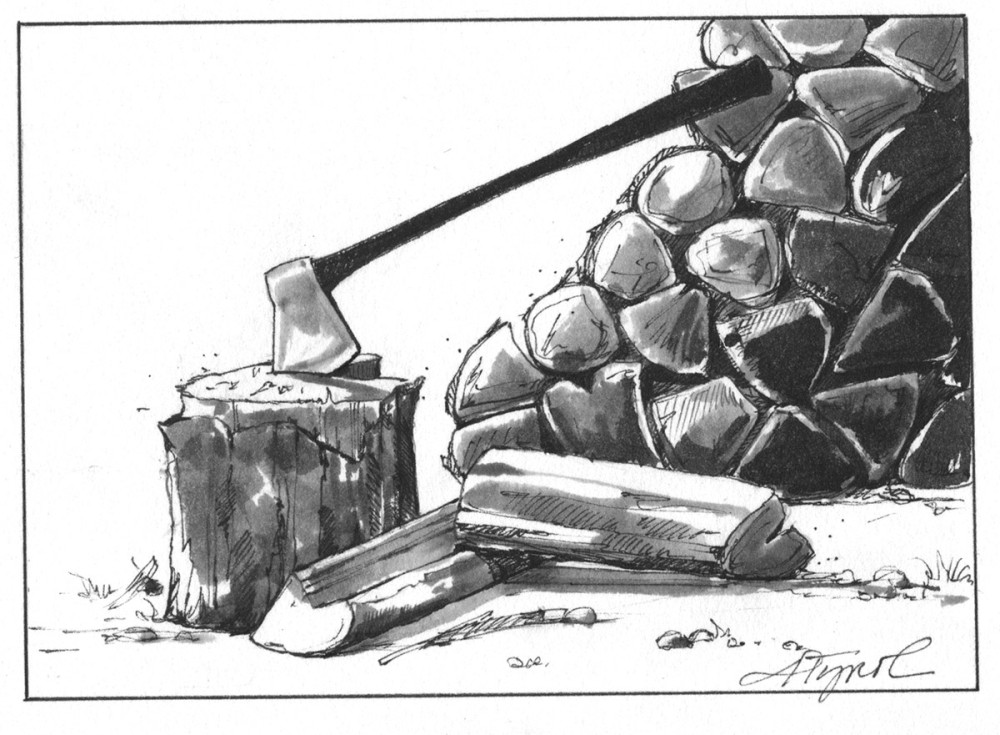
This week feels like fall proper. It’s gray, drizzly, 50s; the kind of weather that makes you realize you’d better batten down the house for winter.
We’re going to get to the first fire of the year in a moment, that pathetic, smoldering pile of hissing wood in your woodstove that you made such a big deal about. “Come here kids!” for the ceremonial lighting of the hearth, which turned into the ceremonial opening of the doors and windows to let the smoke out of the living room. (Write what you know, the English professors advise.)
But first let’s talk about the physiology of a tree.
Trees, like most living things, are full of water. You can imagine a piece of firewood as a mixed bundle of hollow and solid cardboard tubes. The hollow tubes are vessel cells that move water. The solid tubes are fibers that help make wood strong. When a tree is felled, water is trapped in the hollow cell cavities (called lumens), as well as in the cell walls. The amount of water per cell is miniscule, but multiply it by trillions and it really adds up. According to an extension service bulletin, one cord of red oak weighs 4,888 pounds when it’s green and 3,528 pounds when it’s dry. Divide the difference by 8.3 pounds – the weight of a gallon of water – and we learn that 164 gallons disappears, per cord, in the evaporation process.
So all this water has to migrate out of the wood before it will burn well. Water moves more easily with the wood’s grain than across the grain, so the path of least resistance is out the ends of the wood. In other words, the shorter your pieces, the shorter the trip. Some will evaporate through the sides, so you can also speed up the process by splitting each chunk. Bark essentially exists to keep moisture in, so a piece with four cut faces will dry more quickly than a piece with the bark still on. And the smaller you split each piece, the easier it will be for the water to get out.
Now you split your wood in the spring, just like you were supposed to, and the water’s still hissing out the ends of it in your stove in October. So why didn’t it dry right? Well, the drying process depends on three things: temperature, turbulence, and time. (I’m hearing the “Three T’s” in the voice of Peter Lammert, a forest service icon from Maine from whom I learned the phrase.)
Obviously, heat aids drying. The best place to put a wood pile is in the same full-sun location you’d put a vegetable garden. Stack the wood, don’t leave it in a volcanic-looking heap, so the sun can touch each piece.
The importance of turbulence– i.e. air flow – is often overlooked. Best practice is to stack your firewood so that the prevailing wind is perpendicular and can blast the face of the entire row. A single long row is going to have better airflow than a block of stacked wood or a volcano. A tarp or some plastic on the top of a pile to keep rain off is alright, but do not wrap the pile; you want the wind to blow through and you want the moisture to be able to get out. If you build a woodshed, make the walls like a pallet so air can get through.
Unfortunately, as with all facets of life, the time part is the most difficult to reckon with. The reality is that most people rush their wood. Buying wood in the fall with the idea that you’ll burn it that winter is a rookie move that won’t end well – anyone with at least one year of wood burning experience knows this. But cutting, splitting, stacking in spring, the way so many of us do it (including me), is still not optimal. In my experience, green hardwood that’s been split and stacked for six months will still give you only mediocre fires. By about month nine the wood will be decent. By month 12 it’ll finally be where you want it. All of which is to say that we should really be getting a full year ahead. The old timers with the neatly stacked piles that you never see go down because they sit the first winter are the ones who are doing it right.
“The old-timers with time,” you’re thinking, late for this or that. I hear you. And so we do the best we can. If you can fit a few days’ worth of mediocre fall wood into the living room next to the woodstove, the heat from the fire will be an effective cheat. If you get lemony looks, point out to your partner that the drying wood will moisturize the room and expose the kids to dust and microbes so they won’t grow up soft and asthmatic like the poor buggers in neat-freak urban homes.


Discussion *